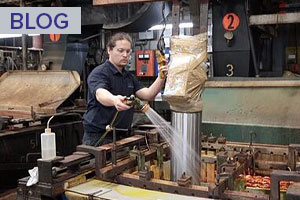Common Hard Chrome Plating Problems
 Due to inevitable wear that comes with cylinder use over extended periods of time, replating the chrome is necessary for maximum cylinder operating effectiveness. One crucial component of hydraulic cylinder repair is hard chrome electroplating.
Due to inevitable wear that comes with cylinder use over extended periods of time, replating the chrome is necessary for maximum cylinder operating effectiveness. One crucial component of hydraulic cylinder repair is hard chrome electroplating.
As with any highly specialised process, hard chrome plating requires precise conditions and technical equipment as well as deep knowledge and expertise to be completed satisfactorily. Any errors in the chrome plating process may lead to defects in the hard chrome surface. This means that the cylinder rod will be unable to perform up to standard, with a poor chroming job invariably causing damage to other cylinder components. Damage to seals for example, will lead to rapid cylinder failure.
Hard Chrome Plating Defects:
1. Dull/Milky Deposits
A dull and poor chrome appearance may be caused by a number of factors, the most common cause being unbalanced current density and bath temperature. This defect may also indicate the presence of chlorides and trap metal contamination such as iron and copper being present in the plating tank.
2. Burnt Deposits
Commonly found near the high current density areas of a cylinder rod, burnt deposits are caused when chromium is deposited too quickly when current density is too high. This extreme built up of chromium deposits are magnified where current is highest – the edges or end of the cylinder rod.
3. Poor or Partial Coverage
Referring to the ‘missed spots’ on a plated piece, this condition may appear as small patches or large sections where metal has not been plated. This condition is most commonly caused by bad chemistry or electrical connectivity issues. Electrical connectivity issues occur when there is poor or intermittent contact between the metal parts and the rack, or when the rack is unable to deliver sufficient current to all areas of the part during plating. Cylinders with poor or partial coverage are not acceptable for hydraulic cylinder rod repair.
4. Poor Adhesion
Poor adhesion occurs when the chrome deposits come off the base metal, appearing as peeling, blistering or lifting away. This occurs when the bond between chrome and base metal is too weak, and is generally caused by poor preparation of the underlying surface. Chrome is deposited onto the base metal of a cylinder during the plating process – this base metal is usually a previously plated surface. Poor adhesion will occur if the new chromium plating is applied over existing chromium that was not removed completely during the pre-grinding process, leaving contaminants, trace metals or oils. Another cause of poor adhesion is insufficient electrical current.
5. Roughness
A rough chrome finish is often also caused by poor base metal condition. Any imperfections on the metal are made more obvious by chroming since chromium follows the metal contour and doesn’t fill in holes or scratches like other finishes such as copper. Furthermore, the uneven areas attract additional current, causing even larger chromium deposits in those regions and worsening the problem. This causes the finished chroming job to be rough and uneven.
6. Pitting
A common problem that causes excessive, small pinholes in the chrome surface, this is often difficult to diagnose and solve due to such few potential causes. Pitting may be due to porous base metal or contamination of foreign material that is not dealt with during pre-plating. Additionally, insoluble materials suspended in the bat during plating will also cause pitting.
7. Excessive Micro-cracking
Micro-cracking is a normal part of the plating process and occurs when fine cracks develop as chromium build up. These cracks are covered by the subsequent layer, and is desirable as the fine cracks provide lubrication channels to aid in decreasing friction. Micro-cracking becomes a problem if it is excessive however, as it will cause surface roughness beyond the threshold. The degree to which micro-cracking occurs varies with temperature and chromium sulphate ratio.
8. Mud Cracking
Also known as ‘chicken wire cracking’, mud cracking refers to course cracking of the chrome surface. This problem is usually caused by improper and poor grinding techniques such as using the wrong grinding wheel, applying the incorrect grinding speed, excessive grinding depth or the incorrect grinding fluid. Mud cracking severely compromises the surface finish and causes the cylinder rod to be more prone to corrosion.
While some of these defects may reduce your cylinder lifespan, others may lead to immediate cylinder failure after repair. With cylinder performance being highly influenced by the quality of your hard chrome finish, it is crucial you choose a reputable and experienced hard chroming facility for peace of mind of a high quality repair. Call CCA Hardchrome today and enjoy the confidence of a high-quality repair.
